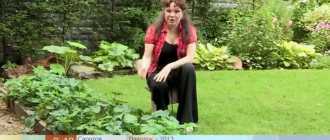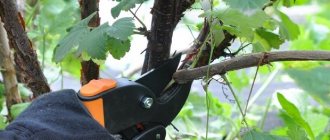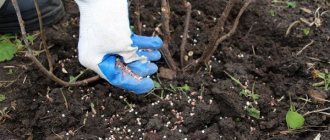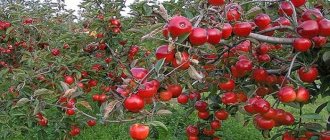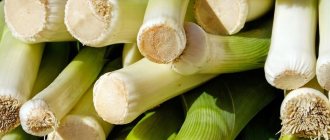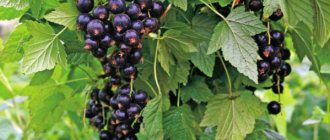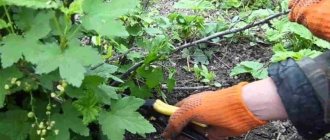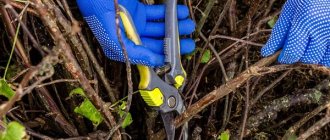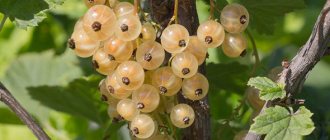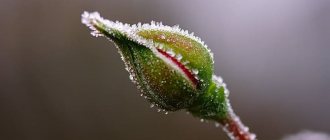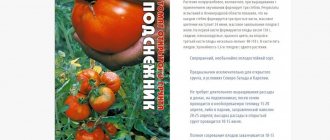Pruning currants after harvest
As soon as fruiting is over and all the berries have been picked, currant bushes require sanitary pruning. It is better to do it with sharp pruning shears. First, cut off diseased, damaged and old thick shoots (they are brown and covered with plaque) that will not bloom next year. Also cut out all the extra root shoots inside the bush, they only thicken it, and too low branches lying on the ground. Shorten powerful annual shoots by 5-8 cm.
As soon as the plant gets rid of ballast in the form of unnecessary branches, it will direct all its energy to laying buds. This means that if all other procedures are followed, a rich harvest will not be long in coming! The denser the bush, the fewer berries it bears. Therefore, do not neglect regular currant trimming.
Everything is clear with pruning the shoots, but what to do with the leaves? In black currants, you can pick them off yourself, especially if they are affected by diseases. This is usually done in the fall. But on the red one, the leaves must fall off on their own, otherwise the plant will experience stress.
If there are good branches left after pruning the currants, cut them into cuttings and use them for propagation. Add healthy leaves to marinades and pickles.
What to do when the harvest is harvested - list of works
Caring for currant bushes and the surrounding soil is carried out approximately in the last days of August. It includes the following activities:
- pruning shoots;
- loosening the soil;
- post-harvest feeding;
- watering;
- prevention of pests.
It is advisable to work in sunny, dry weather, early in the morning or in the afternoon at an air temperature of at least +20.
Timely and high-quality processing of currants after fruiting protects the plant from serious diseases and provides a good harvest for the next summer.
Watering currants after harvesting
Berry bushes need moisture to properly set buds and then overwinter well. After the excess branches and shoots have been trimmed, water the bushes with warm, fresh water. Pour 1-2 buckets under red currants, 3-4 buckets under black currants. The next watering will be only in the fall, before preparing for wintering. Black currants require more abundant watering than red and white ones, because... its root system is located close to the surface of the earth.
Watering
Currants, like all other shrubs and trees, after the end of the fruiting season, are stored for the winter with macro- and microelements and moisture. This helps to survive the cold with minimal loss of internal resources. When autumn is rainy, watering can be omitted, especially if the bush is well mulched.
Preparing for winter will include observing the following rules:
- removing leaves from branches so that they do not draw moisture and nutrients;
- moisture-charging watering if autumn is dry;
- moistening the earthen coma up to 30 cm.
Attention! Fertilizers are applied to damp soil. Therefore, after abundant watering and deep moistening of the soil, it is recommended to feed the currants well.
Loosening the soil under currant bushes
It is also advisable to loosen the soil under the currant bushes to increase the access of oxygen to the roots. There is no need to loosen deeply, just lightly walk the soil crust with a hoe or hoe to remove the weeds. Try to avoid the area near the trunk itself to avoid disturbing the roots. To make it easier to fertilize in the future, make small grooves. Thanks to loosening, it will not be so comfortable for pests to build nests in the soil for the winter.
Fertilizing currants in autumn
Timing for fertilizing
In the first year, the plant does not need feeding if planting was carried out with the addition of mineral and organic substances. You need to feed the bushes every other year. It is important to do this in a timely manner.
At the beginning of August, currants stop bearing fruit. After picking the berries, it’s time to fertilize the bushes with organic compounds - chicken droppings or slurry. You can feed with ready-made complex products or single-component formulations.
In the fall, by the end of September, the addition of nitrogen-containing components is stopped. Their excess in the soil will enhance the development of young shoots; with the first frost, the currants may die.
After completing the application of nitrogen elements in the fall, the currants should be fed with phosphorus-potassium fertilizers. Compost and humus, rich in these components, are added to the soil during the dormant period of shrubs from September to December. These substances do not decompose immediately and have a positive effect on the condition of the root system. In winter, they will begin to release elements necessary for spring growth and development of plants.
Types of fertilizing: root and foliar
In gardening, there are 2 methods of applying fertilizers:
- Root feeding - fertilizers are applied at the root (in dry or liquid form). This method is the main way to feed garden crops.
- Foliar feeding - spraying of the aboveground part of the plant (leaves, trunk). The plant absorbs nutrients, but the beneficial effect of feeding has a shorter period. Technology is auxiliary to the first method.
In autumn, it is better to feed currants using the root method, because it has a prolonged effect and slowly nourishes the bush.
And further…
In addition to the procedures described above, working with currants after harvesting includes several more mandatory care items.
- Weeding
Many people believe that it is not necessary to weed currant bushes after harvesting, and leave weed removal until the fall. This is a typical mistake of novice gardeners, which next summer will result in a decrease in the taste of the berries and the harvest. This fact is easily explained and predictable: at the end of July and beginning of August, fruit buds are formed, which need the maximum amount of nutrients. Weeds, which clog the root system of the bush and take away useful microelements from the soil, prevent this.
- Watering
Currants love moisture and need abundant watering even after the harvest is harvested. Frequency depends on weather conditions. On average, the procedure is carried out once every 10 days with a water consumption of 50 liters for each bush. Foliar irrigation is not recommended as it increases the risk of developing powdery mildew.
- Loosening
The goal is to improve the aeration of the root system. This is done every time after watering. Requires extreme care, since the roots of the shrub do not lie deep.
- Mulching
Allows you to reduce the frequency of loosening, inhibits the growth of weeds, and retains moisture after watering. The mulch layer should be at least 6 cm. Recommended materials are peat, hay, sawdust, straw.
How to fertilize currants in the fall
Fertilizers are divided into organic and mineral. Each group has its own advantages and disadvantages. The best result is achieved with the combined use of both types.
Mineral fertilizers
Produced in chemical plants. Contains inorganic nutrients necessary for plants:
- phosphorus;
- nitrogen;
- potassium
Minerals must be used with caution so as not to spoil the fertile soil layer.
Organic fertilizers
These include animal waste products, sawdust, tops, peat, compost, humus. They are part of the ecological chain and are not capable of harming the soil.
Ash
Rich in potassium and phosphorus. The norm is 25 g per bush. Loosens the soil and changes its acidity. Coal ash, unlike wood ash, is not used as fertilizer. There is almost no nitrogen and chlorine in the ash. Contains about 30 useful microelements. All elements are easily absorbed by currant roots. The effectiveness and quality of this fertilizer depends on the raw materials. Coniferous trees produce ash rich in phosphorus. Deciduous - calcium. Herbaceous plants and grapevines supply potassium to currant bushes.
Wood ash is added together with compost and peat. For feeding, a mixture of liquid manure, ash and microfertilizers is used, which is filled with water in a ratio of 1:2. Leave for 5–7 days, mix daily with added water and apply using the root method. Add ash in the fall so that the soil becomes looser by spring. The effect lasts for 2–4 years.
Potato peelings
Used fresh or dried. Using potato peelings as a top dressing in the fall makes currants more aromatic and tastier. Potato skins are washed with a weak solution of potassium permanganate. Dried in an oven, oven, fruit and berry dryer. Natural fertilizer does not lose its properties even after freezing. Organic fertilizer prepared for future use is stored in the freezer in an airtight container.
Treatment of the bush in August
After ripening and harvesting, plants begin to recover, replenishing nutrients and developing a root system. During this period, it is necessary to create favorable conditions for them so that the garden crop goes into the winter stronger.
To achieve this, the following activities are carried out:
- feeding;
- pruning;
- watering;
- loosening the soil;
- preventative treatment against pests.
It is advisable to pay attention to each of the listed points - without fertilizing, the plants will not receive all the necessary supply of nutrients. In the absence of watering, fertilizers will not be able to be properly absorbed by the garden crop. Tilling the soil will allow you to retain moisture longer, and pruning will eliminate the consumption of microelements on shoots with low productivity.
How to prune correctly?
Currant pruning is also done in the spring. However, due to the fact that with the onset of thaws, gardeners have a lot of other work to do, this procedure can be carried out after harvesting.
The following shoots are subject to removal:
- old people who are more than 4-5 years old, since with age they lose productivity;
- damaged by pests and diseases;
- creeping in close proximity to the ground;
- growing inside the bush and excessively thickening it.
Leaves are removed from blackcurrant bushes before pruning. It is better to leave the foliage on red and white currants; they should fall off naturally with the onset of cold weather. After removing the old branches, 4-5 of the strongest young shoots are left to replace them, which are cut off by a third of the length. Aging tops need to be cut back to the first branch.
Attention! Removed shoots with signs of pest or disease damage must be burned immediately!
Watering and loosening
In order for the currant bushes to lay fruit-bearing buds, the garden crop is watered abundantly after harvesting. Watering is essential if there has been no rain for a long time. If the soil in the garden plot is wet after rainfall, the amount of water indicated below can be reduced.
For watering, it is better to make grooves between the rows of bushes or along the perimeter around the plants. The water should be warm, at least 22-25 degrees. For each red currant plant, it is necessary to add at least 20-25 liters in order to wet the soil to a depth of 0.5 m. Since black currant roots lie somewhat deeper, each bush will require at least 35-40 liters of water, and the soil should get wet by about 0.7 m.
A few days after watering the currants, the soil needs to be loosened. You can also mulch the soil - cover it with sawdust with a layer of 5-7 cm.
Attention! Mulch will not only retain moisture and prevent crust from forming on the surface of the soil, but will also prevent the growth of weeds.
Protection from diseases
While the berries were filling with juice and ripe, obviously no processing was carried out. This was the time of pest activity, which probably managed to multiply and lay eggs. Diseases are also not dormant, especially those of fungal origin.
Even if the currants look outwardly strong and healthy, carry out preventive treatment, it definitely won’t hurt. Any means can be used:
- Fitoverm, Aliot to combat kidney mites;
- Lepidotsid, Inta-Vir if there is suspicion of currant gall midge activity;
- Biotlin, Aktara for aphids.
To prevent fungal infections, especially in damp summers, it is good to spray fruit-bearing bushes with a 3% solution of Bordeaux mixture. To consolidate the result, repeated treatment is recommended after 2-3 weeks.
Preventive treatment of currants
After leaves and unnecessary shoots have been removed from the bushes, preventive treatment of currants against diseases and pests should be carried out, and both problematic and completely healthy bushes should be sprayed. For fungal infections, currants are treated with a fungicide: one percent Bordeaux mixture, iron sulfate, a solution of Topaz, Fundazol or any other copper-containing preparation.
If your bushes are healthy, then they can be sprayed with Fitoverm or Karbofos, preparing a not too concentrated preventive solution. However, if mites, glass beetles, or signs of gall midge infestation are found on the bushes, you will have to make a stronger solution and carry out not one, but at least two treatments. You can read how to prepare a medicinal solution on the packaging of the insecticidal product.
